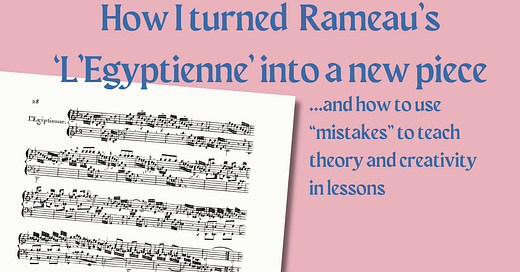
Discover more from PianoCreativity by Garreth Brooke
“What are your favourite improv starters?”
I have several!
I love reacting to students messing around. I wrote about this more here:
Elementary students love Teach Piano Today’s improvisation flashcards. These are free and come on a variety of topics:
I often use activities from Forrest Kinney’s excellent Pattern Play series, including “Blues on Black” from book 1 and many activities from books 3 and 4. This is series published by the Frederick Harris Music Co and is a little tricky to get hold of outside of North America, but it’s wonderful.
With confident, curious students, I love using Impromosaik by Karen Schlimp. This is currently only available in German but there are plans to publish it in English soon.
“What do you do when you encounter reluctant teenagers"?”
It depends: if they’re reluctant to take piano lessons, I don’t take them as students at all.
But if they’re reluctant to try certain activities, including composition, improvisation and arrangement, I look at it differently.
The reality is that not all of my students want to be able to compose or improvise. Teenagers in particular tend not to be excited about it.
But in my experience, teenagers love to arrange the music they love.
My “Magpie Method” is the best way to do this. I wrote about it more here:
Reluctant students can turn out to be the best students.
That probably sounds a bit bizarre, but more often than not, it’s true.
Reluctance is a sign that a student doesn’t truly understand the purpose of what they’re doing.
To persuade them, you need to be able to demonstrate why what you’re doing is important.
This might take a long time.
When I encounter reluctance, I explain to the student why I think it’s important. If after hearing the explanation they’re still reluctant, then we just move onto another activity. Accepting their refusal builds trust.
I then write a note in their records that they were reluctant and I try the activity again in 6 months or so, maybe longer. By that time, they’re usually more willing, but if not, I just wait.
If you wait until they are ready, they usually make rapid progress.
That’s because they can see the point of the activity.
This acceptance and trust-building method works for every pedagogical activity I’ve ever encountered (including composition, improvisation and arrangement). I am fairly sure that following it contributes to my high student retention rate. I also think it leads to a higher likelihood of students really falling in love with the piano, which is my ultimate goal.
It’s a good goal to have.
Ask me a question!
I really enjoyed writing this article. Please do send me your questions!
















